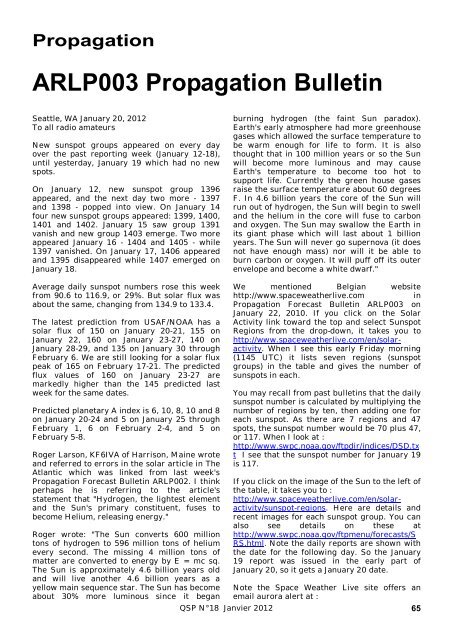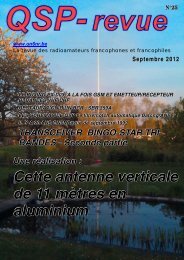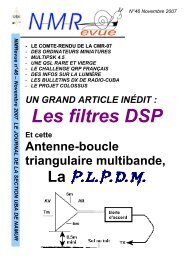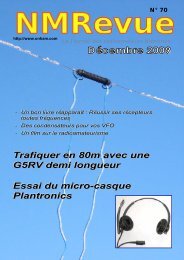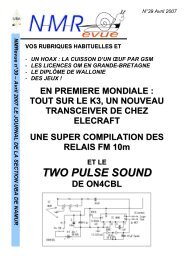Janvier 2012
Janvier 2012
Janvier 2012
You also want an ePaper? Increase the reach of your titles
YUMPU automatically turns print PDFs into web optimized ePapers that Google loves.
PropagationARLP003 Propagation BulletinSeattle, WA January 20, <strong>2012</strong>To all radio amateursNew sunspot groups appeared on every dayover the past reporting week (January 12-18),until yesterday, January 19 which had no newspots.On January 12, new sunspot group 1396appeared, and the next day two more - 1397and 1398 - popped into view. On January 14four new sunspot groups appeared: 1399, 1400,1401 and 1402. January 15 saw group 1391vanish and new group 1403 emerge. Two moreappeared January 16 - 1404 and 1405 - while1397 vanished. On January 17, 1406 appearedand 1395 disappeared while 1407 emerged onJanuary 18.burning hydrogen (the faint Sun paradox).Earth's early atmosphere had more greenhousegases which allowed the surface temperature tobe warm enough for life to form. It is alsothought that in 100 million years or so the Sunwill become more luminous and may causeEarth's temperature to become too hot tosupport life. Currently the green house gasesraise the surface temperature about 60 degreesF. In 4.6 billion years the core of the Sun willrun out of hydrogen, the Sun will begin to swelland the helium in the core will fuse to carbonand oxygen. The Sun may swallow the Earth inits giant phase which will last about 1 billionyears. The Sun will never go supernova (it doesnot have enough mass) nor will it be able toburn carbon or oxygen. It will puff off its outerenvelope and become a white dwarf."Average daily sunspot numbers rose this weekfrom 90.6 to 116.9, or 29%. But solar flux wasabout the same, changing from 134.9 to 133.4.The latest prediction from USAF/NOAA has asolar flux of 150 on January 20-21, 155 onJanuary 22, 160 on January 23-27, 140 onJanuary 28-29, and 135 on January 30 throughFebruary 6. We are still looking for a solar fluxpeak of 165 on February 17-21. The predictedflux values of 160 on January 23-27 aremarkedly higher than the 145 predicted lastweek for the same dates.Predicted planetary A index is 6, 10, 8, 10 and 8on January 20-24 and 5 on January 25 throughFebruary 1, 6 on February 2-4, and 5 onFebruary 5-8.Roger Larson, KF6IVA of Harrison, Maine wroteand referred to errors in the solar article in TheAtlantic which was linked from last week'sPropagation Forecast Bulletin ARLP002. I thinkperhaps he is referring to the article'sstatement that "Hydrogen, the lightest elementand the Sun's primary constituent, fuses tobecome Helium, releasing energy."Roger wrote: "The Sun converts 600 milliontons of hydrogen to 596 million tons of heliumevery second. The missing 4 million tons ofmatter are converted to energy by E = mc sq.The Sun is approximately 4.6 billion years oldand will live another 4.6 billion years as ayellow main sequence star. The Sun has becomeabout 30% more luminous since it beganWe mentioned Belgian websitehttp://www.spaceweatherlive.cominPropagation Forecast Bulletin ARLP003 onJanuary 22, 2010. If you click on the SolarActivity link toward the top and select SunspotRegions from the drop-down, it takes you tohttp://www.spaceweatherlive.com/en/solaractivity.When I see this early Friday morning(1145 UTC) it lists seven regions (sunspotgroups) in the table and gives the number ofsunspots in each.You may recall from past bulletins that the dailysunspot number is calculated by multiplying thenumber of regions by ten, then adding one foreach sunspot. As there are 7 regions and 47spots, the sunspot number would be 70 plus 47,or 117. When I look at :http://www.swpc.noaa.gov/ftpdir/indices/DSD.txt I see that the sunspot number for January 19is 117.If you click on the image of the Sun to the left ofthe table, it takes you to :http://www.spaceweatherlive.com/en/solaractivity/sunspot-regions.Here are details andrecent images for each sunspot group. You canalso see details on these athttp://www.swpc.noaa.gov/ftpmenu/forecasts/SRS.html. Note the daily reports are shown withthe date for the following day. So the January19 report was issued in the early part ofJanuary 20, so it gets a January 20 date.Note the Space Weather Live site offers anemail aurora alert at :QSP N°18 <strong>Janvier</strong> <strong>2012</strong> 65


